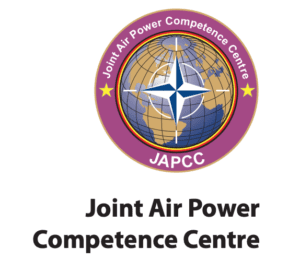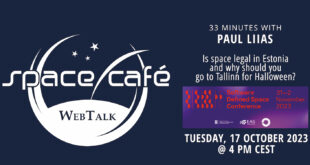 As part of the partnership between SpaceWatch.Global and Joint Air Power Competence Centre, we have been granted permission to publish selected articles and texts. We are pleased to present “Space Traffic Management – Impact of Large Constellations on Military Operations in Space”, originally published by the Joint Air Power Competence Centre for the Conference Read Ahead 2020.
As part of the partnership between SpaceWatch.Global and Joint Air Power Competence Centre, we have been granted permission to publish selected articles and texts. We are pleased to present “Space Traffic Management – Impact of Large Constellations on Military Operations in Space”, originally published by the Joint Air Power Competence Centre for the Conference Read Ahead 2020.
by Mr. Marc Becker, DLR Space Administration, Bonn, Germany
As Space Actors Consolidate their Approaches to Space Traffic Management, What is the Role of the Military?
Space Traffic Management (STM) is currently one of the hottest topics in space policy. While a consensual definition of the term is yet to emerge, it becomes increasingly clear that the international community has to find ways to protect space infrastructure and guarantee the safe and sustainable use of outer space in the long run, amid an ever-growing number of actors and objects in the space domain.
Often seen as a primarily civilian function, a future STM regime could affect military space operations and space support to operations in a number of ways. Military stakeholders should therefore assess the challenges and opportunities associated with STM and become more engaged in the ongoing debate.
What Will Space Traffic Management Look Like?

The advent of large constellations launched by commercial providers such as SpaceX has created a sense of urgency that has put STM on top of the space policy agenda in recent years: US President Donald Trump issued the first national STM policy (Space Policy Directive-3) in June 2018; the United Nations Committee on the Peaceful Uses of Outer Space approved 21 guidelines for long-term sustainability of space in June 2019; and Germany launched an initiative towards a common European approach on STM during its European Union (EU) Council Presidency in the second semester of 2020, to name only a few recent initiatives.
Academic and technical concepts of STM, however, date back at least to 2006, when the International Academy of Astronautics (IAA) released its first Cosmic Study on Space Traffic Management. The study defined STM as ‘the set of technical and regulatory provisions for promoting safe access into outer space, operations in outer space and return from outer space to Earth free from physical or radio-frequency interference’.1 In broad terms, STM may cover everything from the coordination of satellite maneuvers and the allocation of frequencies and orbital slots to the prevention and mitigation of space debris.
Following the publication of the IAA study, some in the field have come to expect the emergence of a legally binding international STM regime, similar to how air traffic in the civil aviation domain is governed and controlled today. However, given the slow decision- and law-making processes, especially in times of political stalemate, at the United Nations bodies in charge of governing the uses of outer space, a legally binding STM regime with effective enforcement mechanisms appears extremely unrealistic in the short or medium term.
Moreover, an effective STM regime cannot focus exclusively on civilian space activities. Other than in the aviation domain, civilian missions in space cannot be easily distinguished and separated from military missions, which take place at the same time and in the same orbits – even in times of crisis.
A Multifaceted Concept
Recent studies pointed out that regulation is only one of several relevant functions of the STM concept. Other functions include space traffic monitoring and coordination, which will likely continue to be performed on the basis of non-binding standards and cooperation between the different stakeholders.2 In fact, US Space Policy Directive-3 envisions a binding regulatory approach on the national level only, covering issues like space debris mitigation.
Stating that STM shall mean ‘the planning, coordination, and on-orbit synchronization of activities to enhance the safety, stability, and sustainability of operations in the space environment,’3 the policy makes clear that in the global context, the US should focus on establishing best practices and norms of behavior.
In some ways, the EU seems to move in a similar direction: The European External Action Service launched a public diplomacy initiative aimed at promoting sustainable behavior in space in 2019. In terms of space monitoring, the EU has consolidated a unique governance model for its operational European Space Surveillance & Tracking (EU SST) capability.
A consortium of member states in cooperation with the EU Satellite Center provides a growing user community of over 60 organizations with free services including collision avoidance, fragmentation and re-entry analysis. Today, the services protect over 130 European satellites from the risk of collision. Under the new EU Space Regulation, EU SST will evolve into a European space situational awareness (SSA) program, which in the words of EU Commissioner Thierry Breton should be seen ‘as the precursor of a European Space Traffic Management system.’4
All this indicates that whatever we will call STM in the future will likely consist of a mix of existing activities and programs, emerging norms and best practices, and some degree of national (and perhaps also international) regulation. All relevant stakeholders – government and industry alike – are therefore well advised to shape the ongoing debate on STM according to their interests.
While military actors may not be particularly interested in how exactly civil and commercial space activities will be coordinated in the future, it is clear that they will continue to play a significant role in the operational SSA capabilities that are needed to underpin any form of STM, whether for general traffic monitoring or for verifying compliance with norms and regulations.
Indeed, while US Space Policy Directive-3 envisions a transfer of basic STM services such as collision avoidance support to the US Department of Commerce, the authoritative catalogue of space objects – including those that are classified – will remain with the Department of Defense, which operates the US Space Surveillance Network.
Similarly, Europe’s civil EU SST framework is based on a functional specialization of the participating member states. They retain full control over the contributing radars, telescopes, and lasers as some of these sensors are operated by the military and provide sensitive data.
Essential Military Contributions
Precisely because military capabilities and contributions will continue to be essential for any form of STM, it makes sense from a military perspective to assess how a changing environment may affect military space operations and space support to operations in the future.
If the projected unprecedented launch of tens of thousands additional satellites over the next ten years materializes, more precise SSA data will be needed to manage the increased traffic and avoid disastrous collisions in orbit. The number of close conjunctions between objects in space is already remarkable today: In 2018 alone, the US military issued roughly nine million conjunction notifications to satellite owners and operators.5
As the number of close conjunctions continues to rise, we may be starting to see a paradigm shift towards ever more transparency in the space domain. In fact, the US government recently started to provide orbital elements for a number of previously classified objects through its public catalog at space-track.org. However, SSA experts have pointed out that some 500 objects remain restricted for national security reasons.6
In the coming years, there could be an incentive to declassify additional data in the interest of safety of flight. After all, it is difficult to disguise some objects without increasing the risk of collision for all, especially when the respective orbits get much more congested. Operators of military satellites therefore will have to reconcile new transparency requirements and national security constraints in their approach to SSA data sharing.
As more and more countries and even commercial providers develop their own sensor capabilities, it becomes increasingly likely that such data will be available elsewhere, perhaps beyond the respective state’s control. Amateur astronomers have little difficulty in tracking the trajectories of many classified satellites today, and so it won’t be a problem for potential adversaries either.
However, if Western military organizations started to publish precise and timely orbital information of their reconnaissance satellites, for instance, this would allow a broader audience to infer spacecraft capabilities, operational procedures, and mission objectives. In their approach to STM, they will therefore have to strike a balance between promoting space safety and protecting legitimate security interests, which for example could be reflected in the quality and time accuracy of the data released for certain objects.
Considering Challenges and Opportunities of Space Traffic Management
STM standards and norms could be another area in which Western military operators will need to sharpen their approach, even if a future STM regime may largely grant freedom of action for military space activities. In a more crowded orbital environment, particularly in Low Earth Orbit (LEO), commercial spacecraft could increasingly get in the way of military satellites.
Operating and maintaining the planned mega-constellations will require much more frequent launches, as well as regular orbit raising and re-entry maneuvers that cross LEO regions, which are commonly used by reconnaissance and other national security satellites.
Operators of military spacecraft need to carefully analyse what the increase in traffic will mean for military space operations and space support to operations. For example, one can imagine a situation in which the availability of geospatial intelligence of a crisis region could be delayed as reconnaissance satellites need to coordinate their maneuvers with commercial operators of mega-constellations and are forced to prioritize collision avoidance maneuvers over operational needs. National security entities will have to include such potential delays in their calculations.
While emerging STM norms and best practices could place new burdens on military operators, they also have a lot to gain from rules of the road in the space domain. Once established, compliance with norms of behavior in cases of close conjunctions between space objects can be more easily verified as more SSA data becomes available. Consequently, any indication of non-compliance will help to single out potentially hostile behavior in orbit.7
Despite little progress in recent years in the international debate on norms of responsible behavior in space, military actors should continue to push for such norms. Western military groups in particular can bring their long-standing operational expertise to the discussion table, from which best practices can be derived as a starting point for norm development.
Even though many of the exact characteristics of a future STM regime remain murky, now is a good time for all stakeholders, including the military, to analyze the challenges and opportunities associated with different scenarios of how STM could play out. This will allow them to prepare early for future developments and enable them to get more closely involved in the debate where their interests are affected.
Endnotes
1. Contant-Jorgenson, C., P. Lála, and K.-U. Schrogl. Cosmic Study on Space Traffic Management, Paris: International Academy of Astronautics, 2006: p. 10.
2. Moranta, S., T. Hrozensky, and M. Dvoracek. Towards a European Approach to Space Traffic Management, Vienna: European Space Policy Institute, 2020: p. 8.
3. White House, ‘Presidential Memoranda, Space Policy Directive – 3, National Space Traffic Management Policy’. Jun. 2018. Available from https://www.whitehouse.gov/presidential-actions/space-policy-directive-3-national-space-traffic-management-policy; accessed 25 Feb. 2020.
4. European Commission, ‘Closing Speech by Commissioner Thierry Breton, 12th Annual Space Conference’. 22 Jan. 2020. Available from https://ec.europa.eu/commission/commissioners/2019-2024/breton/announcements/12th-annual-space-conference-closing-speech_en, accessed 25 Feb. 2020.
5. de Selding, P.B., ‘U.S. Space Surveillance Unit: Few Issues with SpaceX Starlink; Universities are Toughest Cubesat Owners for Us’. In Space Intel Report, 17 Jul. 2019. Available from https://www.spaceintelreport.com/u-s-space-surveillance-unit-few-issues-with-spacex-starlink-universities-are-toughest-cubesat-owners-for-us, accessed 20 Feb. 2020.
6. Kelso, T.S., ‘Keynote Address, 6th Space Traffic Management Conference’. In CelesTrak, 20 Feb. 2020. Available from https://celestrak.com/publications/STM/2020, accessed 25 Feb. 2020.
7. Schaffer, A. M., ‘The Role of Space Norms in Protection and Defense’, Joint Forces Quarterly, no. 87 (2017): pp. 88-92.

Marc Becker is a policy officer in the department of space situational awareness at DLR Space Administration in Bonn, Germany. He chairs the European Space Surveillance & Tracking (EU SST) Consortium’s internal Security Committee. Mr Becker studied international affairs and security at the Hertie School of Governance and Georgetown University.
The original version of JAPCC Conference Read Ahead 2020, Space Traffic Management, pp. 57-63 can be downloaded here JAPCC_Read Ahead_2020_Space_Traffic_Management_57_63





